Customizing Word Toolbars
|
| < Day Day Up > |
|
Word comes equipped with a great many toolbars—some old, some new. The toolbars customize themselves to suit you—the buttons you use most often are the ones that appear on the Standard and Formatting toolbars. You can further customize the toolbars by adding or removing selected buttons or by creating new buttons and toolbars as you need them.
Showing ScreenTips and Shortcut Keys on Toolbars
By default, Word displays ScreenTips when you position the mouse pointer over buttons on your toolbars. You can disable ScreenTip display, if you choose, and you can add shortcut keys to your ScreenTips. Here are the steps:
-
Choose Tools, Customize. The Customize dialog box appears.
-
Click the Options tab, as shown in Figure 5-2. Then select your options as follows:
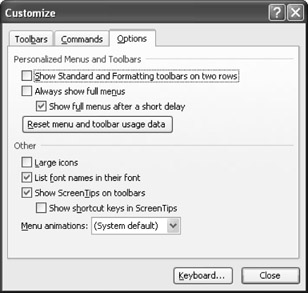
Figure 5-2: You can configure how ScreenTips and shortcut keys in ScreenTips are displayed.-
To disable ScreenTips, clear the Show ScreenTips On Toolbars check box.
-
To add shortcut keys to the ScreenTips, select both the Show ScreenTips On Toolbars and the Show Shortcut Keys In ScreenTips check boxes.
-
-
Click Close. If you've enabled both options, the ScreenTips now appear when you position the pointer over buttons on toolbars, and shortcut keys will be included in the ScreenTip.
Displaying Large Toolbar Buttons
If you want to increase the size of the buttons on your toolbars, you use a Word customization setting. To increase the size of your toolbar buttons, follow these steps:
-
Chose Tools, Customize. The Customize dialog box appears.
-
Click the Options tab.
-
Select the Large Icons check box, but be forewarned: the icons in your workspace will be HUGE! If you want to reverse the effect, clear the Large Icons check box. Click Close to make the change.
Modifying Existing Toolbars
You can also change existing toolbars by adding or removing toolbar buttons, adding new buttons, moving buttons among menus, or reordering the buttons that appear on individual toolbars.
Adding a Button to an Existing Toolbar
Every toolbar in Word has its own Toolbar Options button. Position the pointer over the arrow at the far right end of a toolbar, and the Toolbar Options ScreenTip will appear, as shown below. Click the arrow and a menu of toolbar choices appears. Depending on how you have your toolbars configured, the options you see may include tools that aren't visible on the current toolbar.

To add a button to a toolbar, follow these steps:
-
Click the Toolbar Options arrow. A menu appears.
-
Choose Add Or Remove Buttons, and then choose the toolbar's name from the menu. (For example, for the Standard toolbar you would choose Add Or Remove Buttons, Standard.) A submenu appears, displaying all buttons available for the selected menu, as shown in Figure 5-3. Buttons that currently appear on the toolbar are marked with a check mark; buttons not used show only the button image and name.
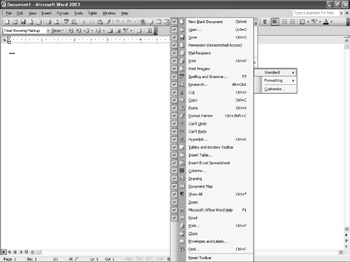
Figure 5-3: The Standard submenu shows all the buttons available for the Standard toolbar, with a check mark next to each one currently shown on the toolbar. -
Click the button or buttons you want to add. The button is instantly added to the toolbar you're working with.
-
Click outside the menu to close it.
Tip Reset toolbars If you make changes to a toolbar and then decide to change what you've done, you can restore the toolbar's previous setup. To revert to the original toolbar, choose Tools, Customize to display the Customize dialog box. Click the Toolbars tab. Click the name of the toolbar you want to reset, and then click Reset. The Reset Toolbar dialog box appears, asking you to indicate the name of the template that stores the toolbar you want to restore. Click the arrow and choose the template, and then click OK to restore the original toolbar settings.
Creating Custom Toolbars
If you have special applications or a set of tools that you use frequently, you can create your own custom toolbar to make those tools available the way you want them. You can create a custom toolbar using the Customize dialog box by following these steps:
-
Choose Tools, Customize. The Customize dialog box appears.
-
Click the Toolbars tab, and then click New. The New Toolbar dialog box appears.
-
Type a name for the new toolbar in the Toolbar Name box.
-
Click the Make Toolbar Available To arrow, and then choose the name of the template in which you want to make the toolbar available. Click OK, then Close. A new toolbar is placed in your work area.
Adding Buttons to a New Toolbar
Next, you need to add tools to the toolbar you've just created. Follow these steps:
-
In the Customize dialog box, click the Commands tab, as shown in Figure 5-4.
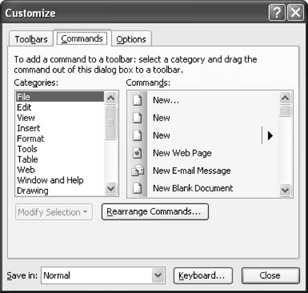
Figure 5-4: Create your own toolbar by copying and combining existing buttons. -
In the Categories list, click the name of the menu that contains the command you want to add to your new toolbar.
-
In the Commands list, scroll to the command button you want to use. Drag the button to your new toolbar. A copy of the button is placed on the new toolbar.
-
Repeat steps 2 and 3, selecting first the menu and then the command, until you've added all desired buttons to your toolbar.
-
Click Close to close the Customize dialog box and begin working with your toolbar.
Tip Copy buttons between toolbars The process of creating a new toolbar requires that you copy buttons from one toolbar to another. How do you do this? Just drag and drop. Whether you're creating a new toolbar or simply copying buttons from one toolbar to another, dragging works the same way: select the button in the Commands list in the Commands tab in the Customize dialog box (choose Tools, Customize to open), and then drag the button to the new location on the toolbar you're modifying.
Changing the Look of Toolbar Buttons
When you're working with the buttons on your toolbars, you might want to change the look of a button you're adding or copying. To change a toolbar button, follow these steps:
-
Choose Tools, Customize to display the Customize dialog box.
-
Click the button on the toolbar you want to modify, and then click Modify Selection in the Commands tab in the Customize dialog box.
-
Choose Change Button Image. A palette appears, giving you a number of images you can use in place of the current image on the selected button (as shown in Figure 5-5).
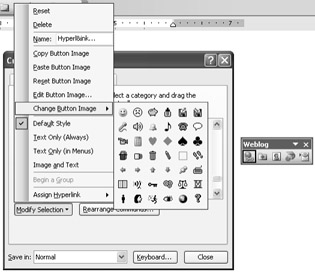
Figure 5-5: You can modify the toolbar button to display a different image. -
Click the image you want to use. The button image is updated on the toolbar. Click Close.
Editing Button Images
If you really enjoy customizing your buttons, you might want to edit button images to create your own look. To edit a button image, follow these steps:
-
Display the Customize dialog box by clicking Tools, Customize.
-
Click the button on the toolbar you want to change.
-
Click Modify Selection in the Commands tab in the dialog box.
-
Choose Edit Button Image from the menu. The Button Editor dialog box appears, as shown in Figure 5-6.
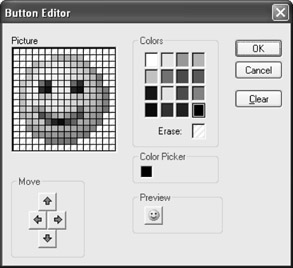
Figure 5-6: The Button Editor dialog box enables you to edit button images.To edit the button image, click the color you want to use and click individual pixels to change the color of the image or to turn the color on or off. Use the directional buttons in the lower-left corner of the dialog box to move the image on the surface of the button. When you've made all the modifications you want, click OK to close the dialog box and record the changes.
Adding Divider Lines to Toolbars
Divider lines on toolbars help you visually group buttons with similar functions. If you've added a number of buttons to your custom toolbar, you might need to add divider lines to help you locate the tools you need more easily. To add a divider line, follow these steps:
-
Display the toolbar you want to change.
-
Choose Tools, Customize to display the Customize dialog box.
-
Click the Commands tab.
-
Click the button to the left of which you'd like to add the divider line.
-
Click Modify Selection, and then choose Begin A Group from the menu that appears. A divider line is added to the left of the button you selected.
-
Click Close to close the dialog box.
Tip Rename a custom toolbar You can easily rename a toolbar you've created by choosing Tools, Customize and then clicking the Toolbars tab. Next, select the toolbar you want to rename in the Toolbars list, and then click Rename. When the Rename Toolbar dialog box appears, type the new name, and then click OK.
|
| < Day Day Up > |
|
EAN: 2147483647
Pages: 373